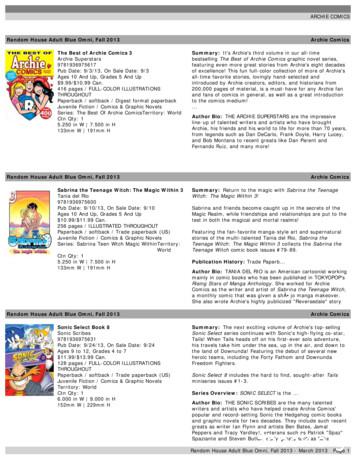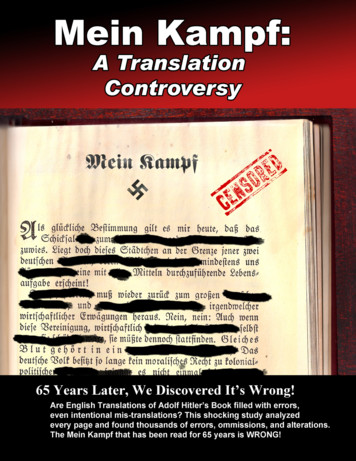Illustration Courtesy Of Archie Comics
Illustration courtesy of Archie Comics
Ms.Grundy’s right! YOUCAN TEACH READING WITH.comics& gRAPHICNOVELSMr. Weatherbee, don’t blow your top.It’s actually a good thing. By Samantha Cleaverillustration: TM & 2008 Archie Comic Publications, Inc.Not so many years ago, comic books in school were considered the enemy. Kids caught sneaking comics betweenthe pages of bulky—and less engaging—textbooks werelikely sent to the principal. But now comics, includingclassics such as Superman but also their generally morecomplex, nuanced cousins, graphic novels, are not onlyregarded as educational tools by savvy teachers, they are also taken seriously as literature and an art form in their own right. Comic books can be agreat way to pique reluctant readers’ interest and challenge those studentswho are fluent in more traditional literature.When fourth-grade teacher Kathy Campbell asked her class atFruchthendler Elementary in Tucson, Arizona, what they wanted to study,instructor may/june 200829
best practicethe response was unanimous: comicbooks. At the time, Campbell, whoworks as a volunteer art teacher, didn’tknow a thing about comics. But afterstudying Columbia University’s ComicBook Project (www.comicbookproject.org), she formulated a plan.Using the theme “If I were a superhero,” her students wrote and analyzedessays that they eventually used to create their own comic books. “They tookthe written word and pulled it apartsentence by sentence,” Campbell says.“They had to investigate how they wouldtransform their writing into characterand dialogue.” At first, says Campbell,the kids had trouble visualizing theirstories, but in the end they producedcreative work.“If we show kids how the writtenword actually has a visual componentto it,” she says, “and teach kids how tothink that way, I think they’ll becomemuch better writers. Their word choiceis much richer, and their creativity isboundless.”Comics and the New Media LiteracyThere’s been a stigma against comicbooks in America, says Wiley Miller,comic artist and author of the OrdinaryBasil series, whether because we don’trecognize comics as appropriate or serious reading, or because we think otherbooks are more valid. Either way, hesays, “trying to dissuade kids fromreading comics is silly and juvenile—ithurts kids.”But today, comics are gaining respectin the educational community. “Theidea of using comic books as an educational tool isn’t new,” says MichaelBitz, founder of the Comic Book Projectat the Columbia University School ofEducation. “Whatis new is the largerembrace of comicsas literature.”There’s moredesire to bringtrying to dissuadekids from readingcomics is silly andjuvenile.When Kids readcomics, they’re usingvisual literacyskills.›FromSonic theHedgehogseries30 instructor may/june 2008the medium into the classroom thanever, agrees James Bucky Carter,Ph.D., author of Building LiteracyConnections with Graphic Novels:Page by Page, Panel by Panel. “Theinstitution of traditional education andprint-based education is still dominating, but I see more and moreteachers asking how they canintroduce comics.”As literature, comics are “a layering of text, visual and pictoral,”says Carter. And don’t think you canjust skim a comic book. The words andillustrations are meant to be “read”together. “As long as you’re readingcomics, you’re using visual literacyskills,” says Carter, whetherthat’s interpreting Batman’sfacial expressions or imagining what’shappening in a description of a scienceexperiment.Kids are at ease with combiningvisual and text information, and as newmedia becomes mainstream, comicbooks offer a way to reinforce traditional grammar and spelling within a layoutthat’s familiar to kids. “Every year thereare new literacies,” says Bitz, and “whenyou look at a comic book, you can seehow it’s a storyboard for a film, or aWeb-based media project. There areconnections to media literacy all alongthe way.” Comics help 21st-century kidsrelate to big themes and topics by tapping into the way students are alreadylearning naturally.The Story of My LifeCreating comics brings the writing process full circle. “You’re a writer first,”explains Miller. “You have something tosay. Then, you’re an editor—you wantto edit as many words as possible—andthen you’re an artist.” That visual orientation doesn’t take away from traditionalreading and writing skills. “Comics arefocused on sequence: First leads tosecond. You have to imagine the storyplaying out in your mind, and betweenthe first and second panels there areinferences about the characters.”Bitz was surprised that Comic BookProject students created stories andcharacters that reflected their own lives,rather than superhero plotlines. Insteadof an excuse to draw Spider-Man, theproject “became an opportunity toself-reflect,” says Bitz, “and explore selfidentity.”Moreover, students known for behavior problems during typical reading andwriting activities were the most engagedduring comic book lessons. “Suddenlythese kids became leaders,” says Bitz.“They collaborated and started to worktogether to become part of education,whereas before they were shut out.”Creating comic books is an opportunityfor kids who struggle with reading toexcel because, says Bitz, “it’s not aboutspeed. It’s about the story and abouthow creative you can be.”(Continued on page 34)
best practicepow! here are some super comics and graphicnovels to keep kids entranced all summer.Laikaby Nick Abadzis (grades 5 )is a historical graphic novelabout a stray dog that joinsthe Russian space programin 1956 and becomes thefirst dog in space.Bone seriesby Jeff Smith (grades2 ) is a graphic novelseries for the youngerset. Marshmallow-likecharacters wanderthrough a valley full ofmagic, monsters, anddragons. The supporting characters, including rat creatures wholove quiche and theminimalist Ted the Bug,are fun and surprising. Smith’s stories arefunny, scary, exciting,and memorable.Sonic the Hedgehogseries (grades 4 ) arezany adventures thatecho comic books ofdays gone by, but withkid-friendly villains,heroes, and predicaments. Each volumecontains severalstand-alone plotlines.Mouse Guardby David Petersen (grades 5 ) is agraphic novel that will appeal to thehero in your students. Realisticallydrawn mice defend their home likeKnights of the Round Table.32 instructor may/june 2008Archie Americana series and ArchieClassics (grades 5 ) brings backArchie, Betty, Veronica, Jughead, andthe rest of the lovable gang as theybecome embroiled in silly hijinks.Watch the gals spar over Archie! Seewho shows up at the Big School Dance!Amelia Rules! seriesby Jimmy Gownley (grades3 ) tells the story of a girlwho’s adjusting to life in anew school while living witha newly divorced mom andyoung aunt. Amelia and herGASP friends (Gathering ofAwesome Super Pals) tellfree-spirited stories from akid’s point of view.American Born Chineseby Gene Yang (grades 6 )is a graphic novel withthree parallel plotlines:a Chinese folk hero,Monkey King, who wantsto rise above his humbleroots; Jin Wang, anAsian-American middleschool student whostruggles to fit in; andDanny, an all-Americancharacter. Yang addresses issues of race, stereotypes, and acceptancein this story that wasa finalist for the 2007National Book Award forYoung People.
best practice(Continued from page 30)Comics for Every CurriculumEnd-of-Year ComicBook Activitieswriting comicsasks kids to bewriters, editors, &artists all at once.Make your last unitof the school year a comicbook unit. Have studentswrite an essay about what they did inschool this year, and then transformit into a short comic book. Or, if yourstudents are younger or time is short,have kids choose their favorite momentfrom that school year and make it intoa comic strip. Then, compile all theircomics into an end-of-year keepsakebook, make a copy for each student, andhost an author signing before you headout the door for summer. This activitycan be made class-specific—make acomic to tell the story of a math lesson34 instructor may/june 2008contributing writer samantha cleaver wrotesmart & Bored (March/april 2008).›1/3 VerticalLeftComics are a way to supplement whatyou’re already studying in class. Usebooks from the Graphic Classics series(www.graphicclassics.com), whichinclude graphic novels and stories fromH. G. Wells to Jack London, to expandon a unit about literature. Working oncharacter development? Try Spider-Man.“The whole mythos of Spider-Man is‘with great power comes great responsibility,’” says author Carter. “That’sa great message for kids.” In visits toschools, Carter uses Spider-Man as aspringboard into discussions aboutidentity with students who are enteringadolescence.You may have to challenge someassumptions before you use comics inthe classroom, and make sure that youread every book before you use it inclass. Just because a book is a comicdoesn’t mean that it’s appropriate foryoung students. If you think it will beat all controversial with your class,consider using an excerpt, selecting adifferent book, or sending a note hometo parents ahead of time.Ready to launch your own comicbook study? Here are some memorableprojects to end the year, as well as booksuggestions that will engage reluctantreaders or challenge highachievers over the summerbreak.or science experiment, for example.Download student-made comicbooks at the Comic Book Project (www.comicbookproject.org) and use thesebooks in class. This is good for afternoons when time is running short butyou still want a quick, satisfying project.Encourage students to make theirown comics over the summer. Give thema template that works for them—a fewboxes for younger kids, a small book forolder students—and directions to followover the summer (a theme, instructionsfor parents, and so on). Remind themthat comics can even be about “ordinary” events. When they return, theycan share their book with the class. Howabout a dramatic reading?Use comic books to teach onomatopoeia. Have students flip throughcomics and identify words that imitatenatural sounds, such as whiz. Have students experiment with replacing thesewords with more mundane, descriptivetext, such as “flies past.” How does thischange the story? Have students drawtheir own panels using onomatopoeia.Be sure to have students share theirwork with one another. One of the greatest thrills of comics, after all, is passingon a cherished volume to a friend.From the Bone series
Illustration courtesy of Archie Comics. N ot so many years ago, comic books in school were con-sidered the enemy. Kids caught sneaking comics between the pages of bulky—and less engaging—textbooks were likely sent to
ARCHIE COMICS Random House Adult Blue Omni, Fall 2013 Archie Comics Archie 1000 Page Comics Extravaganza Archie Superstars 9781936975747 Pub Date: 10/1/13, On Sale Date: 10/1 Ages 9 to 12, Grades 4 to 7 14.99/ 15.99 Can. 1000 pages / FULL-COLOR ILLUSTRATIONS
3. McCloud, Scott. Understanding Comics: The Invisible Art. New York: Harper Perennial, 1994. B. How to Analyze Comics Analyzing comics can be an academic feat considering all the literary and art theory that can be found on a single comics page. A good starting point is familiarizing students with comics vocabulary, literary devices, and art .
Young Archie 2015 competition 1 Young Archie 2015 competition Budding artists between the ages of 5 and 18 are invited to submit a portrait for the Art Gallery of NSW’s Young Archie competition, as part of our family-focused activities for the Archibald, Wynne and Sulman Prizes 2015 exhibition. The portrait should be of a person who is special to you - someone who is known to you and plays a .
A & G Comics 204 Neal Adams Transcontinuity 1119 A Fistful of Comics & Protection 2272 A-1 Comics, Inc. 323 Adventures of the 19XX 1409 Age of Comics 608 Ageless Geeks 1044 All Blue Anime 2055 All Discount Comics 119 Amazing Collectibles 410 Amazingcomics.com 203 Andromeda Designs Ltd 923 Angelarium 1902 An
al., 1984), which is reviewed in Glover (2015). The classical Archie’s laws were based upon experimental determinations. However, there has been progressive theoretical work (Sen et al., 1981; Mendelson and Cohen, 1982) showing that for at least some values of cementation exponent, Archie’s law has a theoretical pedigree, while hinting that the law may be truly theoretical for all physical .
with the Financial Reporting Standard applicable in the UK and Republic of Ireland (FRS 102) (effective 1 January 2015) and the Companies Act 2006. OBJECTIVE AND ACTIVITIES – THE ROLE OF THE ARCHIE FOUNDATION The ARCHIE Foundation ‘Makes the Difference’ when a child is sick or otherwise accessing healthcare. Within
1 PROFESSOR ARCHIE BURNETT: CURRICULUM VITAE NAME Archie Burnett ADDRESS Home 221 Park Street, West Roxbury, Boston, Massachusetts 02132, USA. Work Editorial Institute, Boston University, 143 Bay State Road, Boston, MA 02215, USA TELEPHONE NUMBER AND E-MAIL ADDRESS Home 617–325–4680 e-mail: aburnettjmoore@gmail.com Work 617–353–6631, 617–358–2897, Fax 617–353–6917 e-mail .
Adolf Hitler revealed everything in Mein Kampf and the greater goals made perfect sense to the German people. They were willing to pursue those goals even if they did not agree with everything he said. History can be boring to some, but do not let the fact that Mein Kampf contains a great deal of history and foreign policy fool you into thinking it is boring This book is NOT boring. This is .























